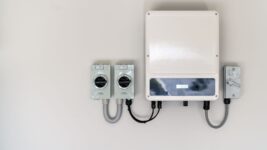
Exploring the Technology Behind Hybrid Solar Inverter Manufacturing Processes

Harnessing the power of the sun to meet our energy needs has become increasingly vital in the fight against climate change. Hybrid solar inverters have emerged as an efficient solution for powering homes and businesses. This is as renewable energy sources continue to gain momentum.
These intelligent devices seamlessly combine solar and electrical energy. But have you ever wondered about the technology behind these innovative devices?
In this blog post, we’ll delve into hybrid solar inverter manufacturing processes. Read on.
The Core of Conversion: How Hybrid Solar Inverters Work
At the heart of solar energy generation lies the need for conversion. This turns the DC generated by the solar panels into the AC used to power our devices. This critical step is where hybrid solar inverters come in.
The Basics of Inversion
Hybrid solar inverters employ complex circuitry to convert the DC input into AC output. This conversion process is essential. This is because the DC generated by solar panels cannot be directly used in the electrical grids or most household appliances.
Distinguishing Features of Hybrid Inverters
Hybrid solar inverters have the unique ability to connect to both the solar panels and a local battery storage system. This means they are capable of managing energy from multiple sources ensuring a constant and stable power supply. These are such as:
●solar panels
●the grid
●stored electricity
Efficiency in Action
Efficiency is a key metric in evaluating the performance of hybrid solar inverters. High-quality inverters on the market boast efficiencies well above 90%.
It means very little energy is lost in the conversion process. This efficiency is crucial for ensuring that the maximum potential of the generated solar power is harnessed.
Material Matters: The Components of Hybrid Solar Inverters
The success of any electronic device hinges on the quality of its components. Inverters, particularly those designed for the harsh and continuous operation environments of solar power, are no exception.
Semiconductor Components
Semiconductors are the workhorses of power conversion in solar inverters. These are such as diodes and transistors.
These devices need to be capable of withstanding high voltages and temperatures. This includes managing power efficiently.
Advanced Semiconductor Technologies
With the evolution of materials science, new semiconductor materials are making their way into inverters. These are like:
●silicon carbide (SiC)
●gallium nitride (GaN)
It offers improved efficiency and reduced size and weight.
Cooling Systems
Inverters generate heat during their operation. This is particularly true when they are converting power at high loads.
Effective cooling systems are necessary to maintain the system’s temperature within acceptable ranges. These include:
●heat sinks
●fans
Good Heat Dissipation Techniques
Manufacturers are increasingly employing innovative techniques to ensure the longevity and efficiency of the inverter. These are such as:

●liquid cooling
●phase-change materials
The Brain of the Inverter: Control Units
The control unit of a hybrid solar inverter is what makes intelligent energy management possible. This unit monitors and manages the flow of energy from different
sources. This is to ensure a stable and efficient supply.
The Complexity of Control Algorithms
Sophisticated algorithms are continuously developed to improve the control units’ ability to adapt to changing conditions. These are such as:
●varying solar irradiance levels
●unexpected load changes
Manufacturing Marvels: The Making of a Hybrid Solar Inverter
Hybrid solar inverters are feats of engineering. This is with the manufacturing process involving a tapestry of specialized techniques and precision assembly. Here are some of those.
PCB Production and Assembly
The heart of any electronic device is the printed circuit board (PCB). In the case of inverters, multilayered PCBs are used to handle the high voltages and currents involved in the conversion process.
High-Voltage Insulation and Traces
Manufacturing high-voltage inverters brings the challenge of designing and producing PCBs, which can insulate appropriately and handle the current. This is without overheating or causing damage.
Enclosures and Housing
The physical casing of the inverter plays a crucial role in protecting the internal components. This is due to environmental factors and ensuring safety for users and technicians.
Ingress Protection (IP) Rating
Inverters designed for outdoor installation or with the intention of rugged use in remote areas require high IP ratings. This is to prevent the ingress of dust and moisture.
Testing and Quality Assurance
The final stage of manufacturing is testing. Inverters undergo various tests, including:
●electrical load testing
●temperature cycling
●performance testing under simulated real-world conditions
Compliance and Certification
Hybrid solar inverters need to comply with international standards for safety and performance. These are such as those outlined by organizations like the International Electrotechnical Commission (IEC).
Navigating the Road to Innovation
Innovation is the lifeblood of the renewable energy industry. Inverter manufacturers constantly seek new ways to improve their products.
This is from increasing efficiency to reducing costs. Here are some of those ways.
Research and Development
Significant investment goes into R&D to explore new:
●materials
●designs
●manufacturing techniques

Advancements in the understanding of materials and the physics of power conversion have a direct impact on inverter technology.
Collaborative Partnerships
Manufacturers often collaborate with research institutions and universities to tap into the latest scientific findings. Also help to accelerate the pace of innovation.
Integration with Smart Grids and IoT
The synergy between inverters, smart grids, and the Internet of Things (IoT) is creating opportunities for unprecedented control. Also, the optimization of energy systems.
Real-Time Monitoring and Control
Inverters capable of interfacing with IoT devices can provide real-time data to energy management systems. It allows for dynamic control based on the current energy landscape.
The Journey toward Standardization
Standardization is key as the industry grows. Common standards across different manufacturers enable compatibility. It also fosters the widespread adoption of
solar inverters.
Global Harmonization
Efforts are underway to harmonize standards globally. It ensures that the benefits of solar technology can be realized on an international scale without barriers.
It is also helpful to consult an expert on solar hybrid inverters. This is to aid in getting insights into solar panel manufacturing. They can also give tips on hybrid inverters for solar.
Use a Hybrid Solar Inverter Today
In conclusion, the technology behind hybrid solar inverter manufacturing processes plays a crucial role in producing efficient and reliable products. Manufacturers can ensure that their products meet the increasing demand for sustainable energy solutions.
This is by staying up to date with the latest advancements in technology. Make the switch and be a part of a greener future.
If you want to read more articles, visit our blog.


















































































